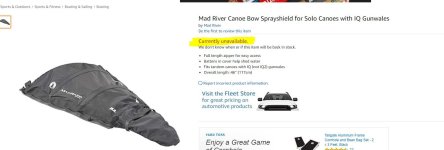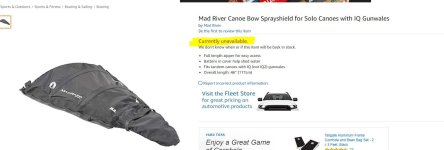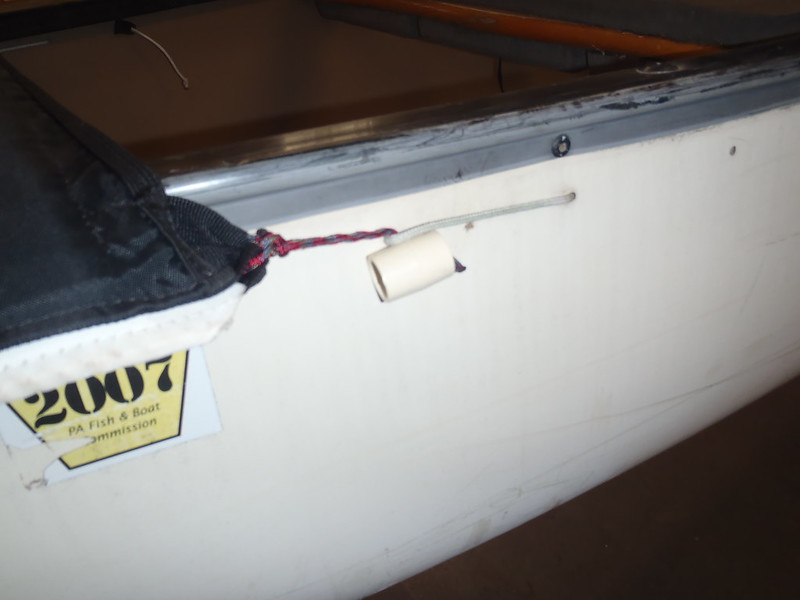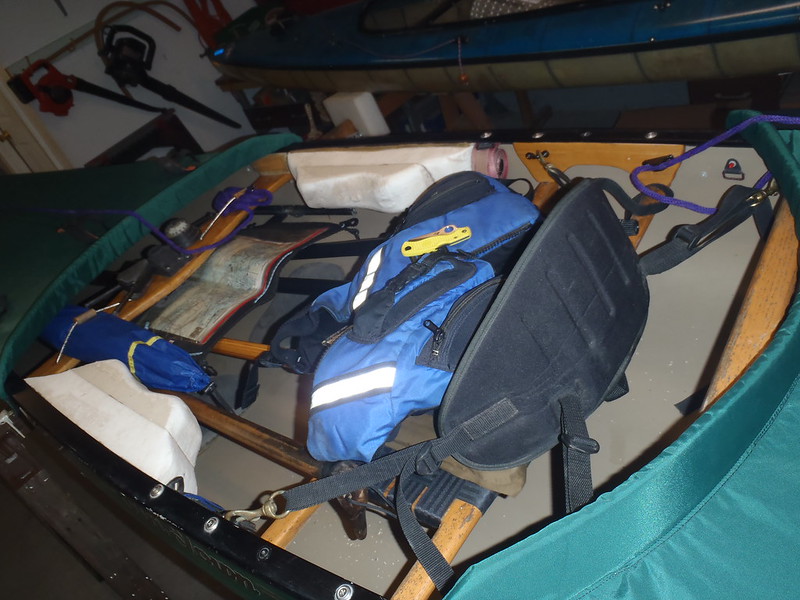Well, you've gotten a lot of spraycoverphilia from Mr. McCrea and you'll hear a lot of good things about them from many others on this forum, I imagine, including a member here who makes perhaps the best on the market, Dan Cooke. (And even he has a warning on
his site about their proper use.)
The caution on the CCS site:
“Note of Warning ...canoe covers are not for everyone! Canoe covers of any design can be life threatening if used without the proper training and practice exiting the skirt under controlled conditions.”
Using partial covers with an open center “cockpit” area largely eliminates any potential entrapment issue. It also eliminates some of the advantages of a full cover, but like everything else canoe compromises must be made. Again, for 90% of what I un-adventurously undertake, partials are perfect.
I don’t want to downplay entrapment hazards, which are present with or without a cover, but the times I have practiced capsizing with a tunnel spray skirt I have popped free with surprisingly little effort or even thoughtful intention.
The closest I have come to entrapment was a rare kneeling extraction, when a boot lace hooked around a too long machine screw on a seat drop. An experience that scared me enough to eliminate that hazard with properly sized hardware and rounded cap nuts, not just on the seat drop hardware, but on all machine screw ends. Hell, I glue short thread protectors on exposed pop rivet shanks, so I don’t catch a finger in a boat rescue
I'll offer the converse opinion: Spray covers are a waste of time, weight and money. And they can be downright dangerous entanglement traps in whitewater. All you need are some good waterproof packs (or pack liners), good rain gear, a sponge, a bailer, some float bags if running whitewater, and some basic knowledge about packing and securing gear in a canoe.
Dan is of course correct, spray covers are not for everyone. I have more tripping friends that have tried spray covers and disliked them than those who like and use them. I fall in the latter category and will offer my counter to the potential downside of covers.
Waste of time: With practice it takes a couple of minutes to install a cover. I need only undo a couple of snaps on either side to extract or reload the dry bags and barrel from either end, so once the bow and stern partials are on I rarely remove anything fully (except the center storage cover) until the end of the trip.
Waste of weight: For funsies I weighed the Wenonah Wilderness CCS partials with center storage cover and Dan’s provided stuff bag, which should be about the same for a full cover. 2lbs, 10oz. Or, in McCrea units, 3.5 cans of beer. Or nearly a kilo of weed, enough to keep even Glenn happy on a long trip.
Packed in the CCS provided stuff bag the 3-piece cover is the size of a loaf of bread, and when removed the center portion is the size of a softball.
Waste of money: My CCS partial covers, with center storage panel, were around $400 at the time. A full sized solo canoe cover, with paddle pockets/strap accessories and a modified rivet tool now runs closer to $600.
I have waterproof packs, good rain gear, a sponge/bailer, float bags for running whitewater, and knowledge about packing and securing gear in a canoe. The knowledge part came at little cost, except early some poorly chosen gear selections and lack of D-rings or tie down points. The current packs, barrel, raingear and float bags cost, eh, another six bills at least.
That is without the PFD, tent, tarp, sleeping bag & pad, water filter, stove and miscellanea; I started totaling that tripping gear up in my head and stopped when I hit $1000. Add to that, if you like, a carbon paddle ($300) and a modern composite canoe $3000+.
Well built and design-proven gear isn’t cheap. The cost of a functional spray cover seems very reasonable in comparison. More so if you have settled on a tripping boat you will own and use for years to come and can amortize the cost over time, trips and miles.
Dan’s response above beat me to it on the possible advantages of a cover. From the CCS site:
Wind, rain, or changing weather conditions, standing waves, or extended trips; these are all situations where a quality canoe cover can make the difference. More than just protecting your gear, a canoe cover will give you greater paddling control and efficiency due to less wind resistance.
I will add some personal observations, starting with exception to Dan’s mention of “far north”. On hot sunny desert rivers a spray covers is as much a boon as in cold weather. Gear shaded under the covers everything stays cooler, and my Snickers bars don’t melt in the barrel.
Plus it’s nice to have some shade for my pale white legs under a desert sun. Same under any sunny summer weather where the ambient water temp is below the air temp; it stays cooler, at least under the open end partials. And most folks roll back their covers in clement water and weather.
I use covers on open water and coastal bay trips where it is often windy. I have no measurable evidence about how much a cover lessens wind resistance or aid efficiency, but it sure “seems” to help, especially in quartering winds.
Or it may simply be that a cover helps prevent me from randomly tossing in a poorly stored glamping load, towering tall above the sheerline. Not that I would ever be inclined to such absurdity.
Covers are unquestionably effective for shedding bow splash and spray in waves, and paddle drips and rain. Even the partial covers keep ¾ of the rain out and drained over the side, so I have to bail/sponge less often.
Beyond that obviousness , and perhaps equally important for my varied spray cover applications:
The paddle pockets and straps provide a secure and easily accessible place for paddles, plural. That single blade, double blade, furled sail, push pole/walking staff handy storage is nearly paramount for mu uses.
I do a lot of base camp paddling, and being able to leave the paddles, PFD, bailer/sponge, map, sail, seat pad, back band etc, all dry, secure and unseen inside the canoe is a huge boon. I can wander down to the canoe unencumbered next morning for a day paddle from camp to find a dry canoe and gear. Nothing gets wet, nothing blows away, everything is there ready to go as soon as I unsnap a few rivet snaps. Sweet!
On occasions I will use only the bow partial. That still provides wave splash and spray protection, sun shielding for the food barrel (and my pale legs) and convenient paddle pocket storage. And some helpful wind occlusion on the front end of the hull.
Hell, I like using covers on dense swampy trips. Low hung branches aren’t grabbing at the thwarts or gear, and most of the swampy leaf litter that would otherwise fall into the hull - twigs and effing sharp pointy holly leaves and weird leggy-arse spiders - stays outside where they belong.
Nope, gimme spray covers, or partial spray covers, or even parts of partial spray covers.
 P7140017 by Mike McCrea, on Flickr
P7140017 by Mike McCrea, on Flickr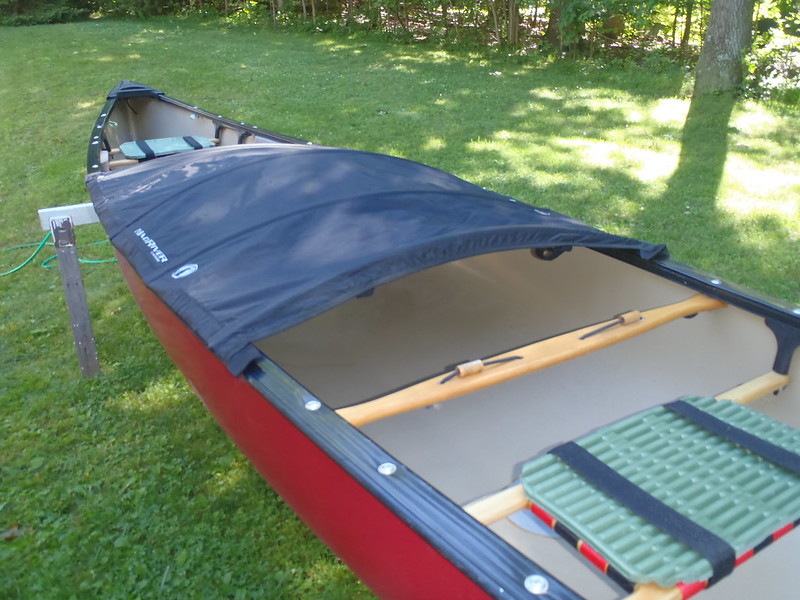 P6100011 by Mike McCrea, on Flickr
P6100011 by Mike McCrea, on Flickr P1220454 by Mike McCrea, on Flickr
P1220454 by Mike McCrea, on Flickr P1220457 by Mike McCrea, on Flickr
P1220457 by Mike McCrea, on Flickr P1220459 by Mike McCrea, on Flickr
P1220459 by Mike McCrea, on Flickr P2160542 by Mike McCrea, on Flickr
P2160542 by Mike McCrea, on Flickr P2160540 by Mike McCrea, on Flickr
P2160540 by Mike McCrea, on Flickr P3090604 by Mike McCrea, on Flickr
P3090604 by Mike McCrea, on Flickr P2160520 by Mike McCrea, on Flickr
P2160520 by Mike McCrea, on Flickr P2160519 by Mike McCrea, on Flickr
P2160519 by Mike McCrea, on Flickr
